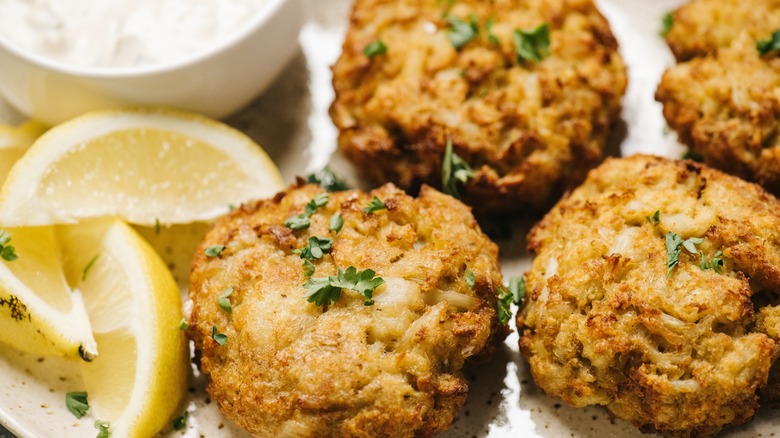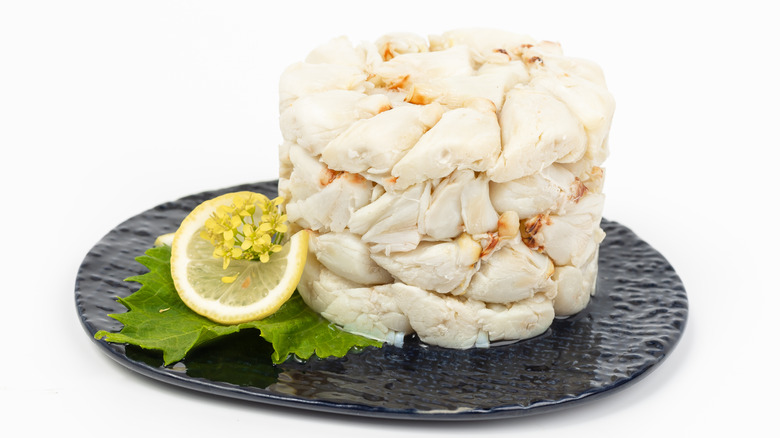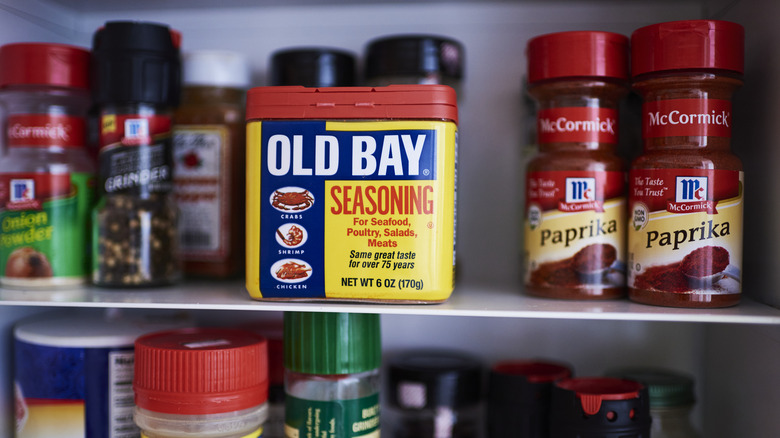The Key To Delectable Baltimore-Style Crab Cakes Is Less Filler
If you're in proximity to Maryland during blue crab season, which runs from April through December, there's nothing better than mixing up a batch or two of Baltimore-style crab cakes. Whether they're served alone atop a crisp piece of lettuce as an elegant appetizer, or squished between two slices of sourdough with a slice of fresh tomato for a sublime sandwich, crab cakes are the kings of coastal menus. If you want to make a crab cake that passes the Baltimore authenticity test there are a few simple rules that you can't break: always season with Old Bay, and use as little filler as possible.
Crab cakes need at least a little bit of bread or cracker crumbs and either egg or mayonnaise to bind the mixture together so that you can form and cook the patties. The secrets of a true crab cake master is to figure out exactly how much filler to include to bind the meat without outshining the delicate flavor of the crab itself. Too much bread will also make your cakes dry, heavy, and sticky.
What's a filler?
Crab meat alone, when it's fresh, should be firm and juicy, bright white in color and have a flaky texture. If you've ever been to a crab boil (another Maryland institution), you'll know that when you pick the meat right out of the shell it's not sticky — it's more like fibers of cornsilk packed together. To make a cake that you can bake, broil, sauté, or fry, you need some binders to get the meat to stick together. Recipes can vary, but they all have some combination of dry breadcrumb and egg (or egg alternative for anyone with allergies). When you mix the dry ingredients with the wet ingredients, the crumbs soak up some of the moisture and expand, which makes the cakes sticky. The protein in the eggs will also stick things together when you heat them up.
It may seem obvious, but the star of the show in Baltimore-style crab cakes should always be the crab meat. This seasonal delicacy is sweet and mild, and can be easily overpowered by adding too many extra ingredients to your crab cake recipe, like fillers, as well as extras like capers, onions, and herbs. It's better to add fewer extra ingredients than you think you need, and then add more filler and flavors after you test your mixture.
Be patient when adding filler
The key when you're adding fillers like cracker crumbs, panko, or breadcrumbs is to add less than you need at first, cover the bowl, then wait for the moisture to absorb. After you've let the mixture sit for a bit, check by scooping a small ball of it into your hands and forming a mini test cake. If it seems to stick together, try sauteeing your baby cake in some olive oil to see if it stands up to the heat. If it starts to fall apart, add a little more filler to your mixture and wait another 10 minutes. If you add more than a ¼ cup of crumbs to the mixture, add a tablespoon or two of extra mayonnaise so that it stays moist.
Once you have your filler dialed in, it's time to add the Old Bay to taste. If you don't have any Old Bay, you can also add some hot sauce, however, the seasoning made with a proprietary blend of herbs and spice was specifically developed in Baltimore, right across from the fish market in Inner Harbor, to be served with fresh Maryland seafood, according to the Washington Post. The blend is so ubiquitous with Maryland that last year that there was even a petition to make an Old Bay-flavored brew the state beer, WTOP reported. So if you want to make your crab cakes truly authentic, keep the filler to a minimum and bring on the Old Bay.


